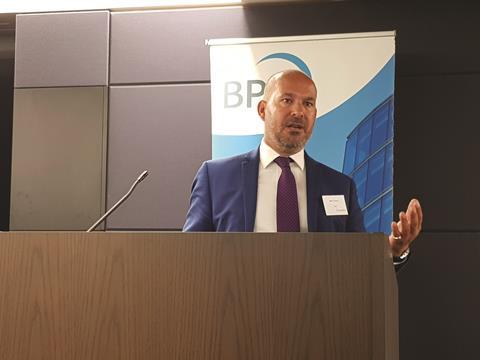A year on from Mark FarmerŌĆÖs dramatic warning that construction must modernise or die, how has the industry responded to the challenge? And did the reportŌĆÖs focus on off-site methods understate the importance of other drivers for change?
One year ago next week, consultant Mark Farmer, having been commissioned by the government to write a report on the future of the construction industry, came back with a very stark message: either modernise or die. His conclusion was that the industry, stuck in survival mode, faced a threat to its very existence from a future of labour shortages and ever-declining profitability. A year on, and the financial shocks to the likes of Carillion and Interserve have only reinforced his case.
The only way out, Farmer concluded, was to embrace a very different way of doing things. Using various off-site construction methods, bracketed together under the heading of ŌĆ£pre-manufactureŌĆØ, was the way forward.
The ŌĆ£modernise or dieŌĆØ title was undoubtedly intended to provoke, making his assessment ŌĆō whether you agreed with it or not ŌĆō impossible to ignore. Richard Ogden, former chair of industry association Buildoffsite and now a director at consultant Acumen7, says: ŌĆ£The key was it wasnŌĆÖt diluted. He stood his ground and said the industry needed a sharp kick up the backside. Everyone will remember it.ŌĆØ But while its title may be memorable, that does not necessarily mean the report has had a significant impact. So, one year on, is it possible to say whether the Farmer report will have a lasting influence?

Accelerated construction
Certainly, the report received a warm welcome from government on its publication, with then industry minister Jesse Norman describing it as ŌĆ£very timelyŌĆØ and making ŌĆ£a strong case for changeŌĆØ. More significantly, communities minister Sajid Javid had the previous month already taken on what were then emerging findings, with the announcement at the 2016 Conservative Party conference of a ┬Ż1.7bn Accelerated Construction Fund, designed to build homes on public land where the use of modern methods of construction is prioritised.
In its formal response to the report, published this July, the government made clear that it was taking on a number of FarmerŌĆÖs broader recommendations around training and skills, and was further looking to encourage off-site construction by setting up a working group with lenders, and by considering planning changes and further ŌĆ£innovation and growth fundingŌĆØ to support off-site firms.
Likewise, many in the industry endorsed FarmerŌĆÖs vision, alongside significant construction clients such as Segro, Argent and off-site pioneer Legal & General.
There are no official figures to chart the usage of pre-manufactured or off-site approaches in the industry, but from anecdotal evidence it is hard to escape the conclusion that interest is rising fast. Rory OŌĆÖHagan, director at architect Assael, says his firm now designs all its build-to-rent schemes using a modular construction approach as standard. ŌĆ£The uptick in interest is tangible. WeŌĆÖre seeing a lot of projects going modular, though there are still viability issues outside London. There are real efficiencies in designing modular construction in from the outset.ŌĆØ
ŌĆØThere are too many apologists that think the industry will struggle on. But IŌĆÖm saying itŌĆÖs going to get worse and worseŌĆØ
Mark Farmer, Cast
Likewise, Kieran White, managing director of off-site construction firm Vision Modular Systems, which produces homes for the likes of Pocket Living from a factory in Bedford, says his businessŌĆÖ turnover is rising by 20% a year. ŌĆ£The level of enquiries has gone through the roof. And these are serious enquiries, not just people wanting to kick the tyres. WeŌĆÖre now working on identifying a second facility,ŌĆØ he says.
However, what part FarmerŌĆÖs report has played in this renewed interest, and what is down to other factors such as the growth in the build-to-rent sector and cost escalation in traditional construction, is difficult to judge. VisionŌĆÖs White says: ŌĆ£MarkŌĆÖs report has certainly been a contributor, and itŌĆÖs made it starkly apparent whatŌĆÖs coming down the line if things donŌĆÖt change.ŌĆØ Certainly, Paul Stanworth, managing director of Legal & General Capital, which has been at the forefront of the shift by investing in a 550,000ft2 off-site factory near Leeds to build thousands of homes, says FarmerŌĆÖs report has provided important reassurance and support for his companyŌĆÖs venture. ŌĆ£The industryŌĆÖs now at an inflexion point, and MarkŌĆÖs report has provided a blueprint for a solution,ŌĆØ he says.
Ian Fletcher, director of policy at the British Property Federation, says use of off-site methods would not stop now, even if traditional construction costs were to fall back. ŌĆ£I donŌĆÖt think the modern-methods revolution will slip back,ŌĆØ he says. ŌĆ£Developers have woken up to the fact it can offer significant advantages.ŌĆØ

Unapologetic
Despite all this, not everyone is convinced. While Modernise or Die does contain a wide range of recommendations, critics say its central focus on off-site construction methods downplays the significance of other drivers for industry change, such as digitisation (building information modelling ŌĆō BIM ŌĆō is not mentioned until page 33 of the report) and moves towards more collaborative working patterns. James Pellatt, head of projects at developer Great Portland Estates, says his firmŌĆÖs use of BIM is driving ŌĆ£astonishing resultsŌĆØ in its current crop of schemes. ŌĆ£Off-site manufacture has its place, but it is not the answer in itself. Whether you are finishing an apartment in a factory or on site, you need co-ordinated information to productively build. Almost every element of the build process needs some trade contractor input, which is why I put as much faith in digital co-ordination at each stage of the construction process,ŌĆØ he says.
ŌĆ£We have enhanced productivity, are finishing to the highest quality, and both main and trade contractors are making money.ŌĆØ
ŌĆ£Off-site manufacture has its place, but it is not the answer in itself. I put as much faith in digital co-ordination at each stage of the construction processŌĆØ
James Pellatt, Great Portland Estates
However, Farmer, founding director of property and construction consultant Cast, is unapologetic about prioritising off-site. ŌĆ£I think other industry pushes like sustainability and BIM have had a limit as to how far they can go. Ultimately, the only way to fundamentally change it is by altering the actual physical delivery of construction on site. Digitisation is an enabler ŌĆō but ultimately all construction sites are analogue.ŌĆØ
Critics also say that the sensationalist title of the report reduced its credibility within the sector and government. Pellatt says: ŌĆ£Construction is not going to die; people will still need new buildings. I think this rhetoric did undermine it,ŌĆØ adding that he has ŌĆ£not got a sense of great government backingŌĆØ for the report. Certainly, this last point is a criticism to which Farmer is sensitive. Because while Modernise or Die has been welcomed within government ŌĆō and London mayor Sadiq Khan appears to be adopting it enthusiastically ŌĆō many of its individual recommendations have either been rejected or remain unimplemented thus far.
For example, recommendations to use the National Affordable Housing Programme to boost off-site construction, and to change planning rules to encourage this, have not yet been taken up. FarmerŌĆÖs call for major change to the Construction Leadership Council (CLC), including greater client involvement, was rejected in the governmentŌĆÖs formal response, as was his suggestion for a client levy to pay for industry innovation if change does not happen quickly enough.

Meanwhile, where the government has taken on FarmerŌĆÖs recommendations, such as with the Accelerated Construction programme and within FebruaryŌĆÖs housing white paper, progress remains slow. Acumen7ŌĆÖs Ogden says: ŌĆ£The public sector is finally realising thereŌĆÖs value in this [off-site]. But the governmentŌĆÖs not really got behind it ŌĆō itŌĆÖs just consumed with Brexit.ŌĆØ
ŌĆ£This was always going to be a medium- to long-term change programme,ŌĆØ says Farmer, who accepts that progress on the Accelerated Construction programme has, somewhat ironically, been delayed (read Mark FarmerŌĆÖs comment piece, right). And while he maintains that reform of the CLC is a work in progress, he admits: ŌĆ£ThereŌĆÖs been the delaying impact of the election thatŌĆÖs put back Accelerated Construction. And the delivery of the white paper messages has not been as quick as IŌĆÖd like. But this is not about direction of travel; itŌĆÖs just about speed of delivery.ŌĆØ
Furthermore, Farmer does recognise that even the present level of government support cannot be guaranteed. ŌĆ£I wouldnŌĆÖt underestimate the role of the Treasury. IŌĆÖm still nervous there are people who donŌĆÖt recognise these bigger-picture issues and that the policy objectives which are supported by the communities department might, in a time of huge political change, get overruled. ItŌĆÖs still a risk.ŌĆØ
Nevertheless, Farmer remains unrepentant on the ŌĆ£modernise or dieŌĆØ branding. ŌĆ£It was very deliberate: it was the message I wanted to give,ŌĆØ he says. ŌĆ£There are too many apologists that think things are always going to be like this and that the industry will struggle on. But IŌĆÖm saying itŌĆÖs going to get worse and worse. I wanted people to understand the seriousness of it.ŌĆØ
Mark Reynolds, chief executive of construction firm Mace, is a supporter of FarmerŌĆÖs agenda but admits the jury is still out on Modernise or DieŌĆÖs influence. ŌĆ£ItŌĆÖs only year one,ŌĆØ he says. ŌĆ£The question is, in year five, has the report increased the productivity of the sector?ŌĆØ For Reynolds, the answer to this will in large part be determined by reform of the Construction Industry Training Board and the shape of the ŌĆ£sector dealŌĆØ that construction manages to get under the governmentŌĆÖs modern industrial strategy. These sector deals hold out the promise of funding for innovation, R&D and support to solve pan-industry problems, with the first likely to be announced in the chancellorŌĆÖs forthcoming autumn Budget. Reynolds says of Sir John EganŌĆÖs 1998 report, Rethinking Construction: ŌĆ£Egan was great, but it never got embedded in the industry. The CLC working under a sector deal is what will actually embed this.
ŌĆ£Industry does need some help, in the same way the automotive and aviation industries got help during their own dark times.ŌĆØ The success or otherwise of that initiative, being led by the CLC, is out of FarmerŌĆÖs hands.
What progress has been made in other areas?
Construction skills
In his report Modernise or Die, Mark Farmer made a series of recommendations designed to improve the training of the construction workforce, including calling for a complete review of the Construction Industry Training Board (CITB), with the body reformed and given a new remit to deliver skills for a modernised industry, and to repair the industryŌĆÖs image. Here the government clearly heeded his advice ŌĆō and that of others ŌĆō by kicking off a top-to-bottom review of constructionŌĆÖs industry training boards, assisted by former chief construction adviser Paul Morrell. MaceŌĆÖs Mark Reynolds says this has been welcome: ŌĆ£CITB had been trying to reform; it had become fat and flabby. But industry had also not taken the lead in making clear what it wanted from CITB.ŌĆØ
However, progress here was delayed by the spring election, with the outcome of MorrellŌĆÖs review not now due to be published until later this month. Steve Radley, policy director at the CITB, says the body, which this week received the backing of the sector in its triennial consensus vote, alongside calls for change, has already begun the process of reform and is poised to take action when the review is published. Earlier this year it published research on what standards and qualifications will be needed for a more factory-based industry, and Radley says it will make its grant schemes easier to access and will focus only on areas in which it can make a difference. ŌĆ£WeŌĆÖve heard industry loud and clear,ŌĆØ he says.
Industry collaboration
Like the Latham and Egan reports before it, Farmer identified an adversarial culture, lack of collaboration and poor levels of investment as key industry problems. To help tackle this he called for a ŌĆ£tripartite covenantŌĆØ between government, industry and clients, driven by a reworked Construction Leadership Council (CLC), along with a renewed focus on new business models that promote collaboration. However, the CLC has not yet, as recommended, brought more private clients on board, and the governmentŌĆÖs formal response to FarmerŌĆÖs report said this was not necessary. And while there is some anecdotal evidence that greater use of off-site construction is challenging established hierarchies, it is not clear that huge progress has been made on collaboration. Rory OŌĆÖHagan, director at architect Assael, says: ŌĆ£IŌĆÖve definitely seen a move to more collaborative ways of working. Working with modular suppliers who do so much of the work reduces main contractorsŌĆÖ ability to work in the traditional way. Instead weŌĆÖre seeing bespoke construction management companies created to co-ordinate it.ŌĆØ But thereŌĆÖs also resistance. ŌĆ£Main contractors are trying to persuade clients that modular is not the way, big time,ŌĆØ says OŌĆÖHagan.
Client levy
FarmerŌĆÖs report said that if enough progress was not being made, the government should introduce a levy of no more than 0.5% of construction cost on clients to pay for innovation. Clients would be able to avoid paying this if they contributed to industry modernisation ŌĆō for example, by specifying off-site construction for their projects. However, the idea has received little support, with the governmentŌĆÖs official response saying it risked ŌĆ£damaging developer confidence and increasing costs.ŌĆØ MaceŌĆÖs Reynolds agrees clients need to reform but says: ŌĆ£I donŌĆÖt agree they should be charged for not doing things.ŌĆØ

Mark Farmer will be speaking at the ║┌Č┤╔ńŪ° Live conference in London on 28 November at a session on ConstructionŌĆÖs Productivity Challenge: Big Idea Pitches
Book your place now at

Formerly deputy editor at ║┌Č┤╔ńŪ° magazine, Joey has worked as a journalist in the sector for nearly two decades.
He currently has a special focus on the Housing Today publication, helping it deliver razor sharp news, analysis and insight.View full Profile
































No comments yet